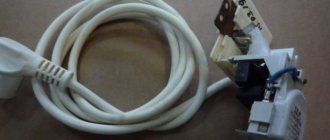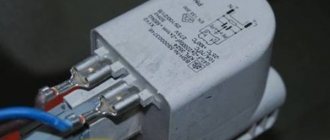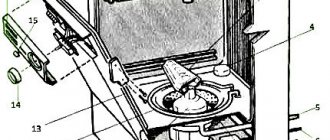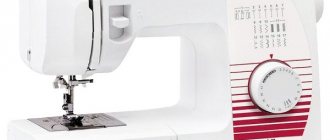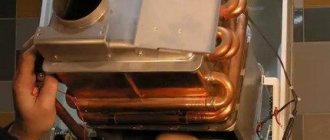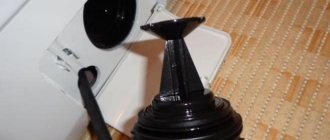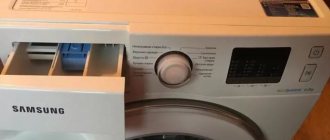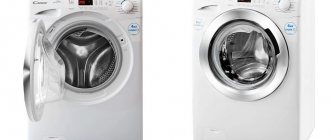Washing machine manufacturers produce sophisticated electronic devices with many functions that make life much easier for their owners. They can do everything - perform high-quality washing, steam and dry clothes. However, “smart” units remain defenseless against hard and rusty pipeline water.
How to prevent damage to your home assistant? This question is asked by many owners and potential buyers of washing machines. One of the effective methods is to install a filter for the washing machine, which protects the working units of the equipment from premature damage.
Let's figure out what types of filter elements exist, what are the features of their selection, installation, application and maintenance. The information presented will help organize comprehensive protection for the washing machine and extend the life of expensive equipment.
The effect of untreated water on washing machine parts
Rumor has it that the washing machine can function smoothly without any filters for many years. However, in modern realities this is far from the case. The reason for this is various impurities that pollute the water. What could they be?
Mechanical impurities (dirt, sand, small debris), if not removed, can over time significantly clog the internal cleaner. The pressure required to start water will gradually drop, which may cause the pump to break down and the device will stop drawing water.
Rust has a detrimental effect on the result of washing, because things fade, acquire new stains or are not washed at all.
If you do not promptly clean the water filter in your washing machine, the purifier will become clogged. And this may lead to machine breakdown
Hard water is no less dangerous. When heated, mineral deposits from the water settle on the heating element and the walls of the apparatus in the form of impenetrable scale. And this can provoke an increase in energy consumption to heat the water to the required temperature.
It is necessary to remove scale in a timely manner, otherwise a more serious breakdown may occur, requiring expensive repairs. To maintain the washing machine, you must periodically use an anti-scale agent.
In addition, hard water provokes corrosion - it is the key reason for the rapid wear of important parts and a decrease in the service life of the machine.
Also, untreated water often becomes a decisive factor in machine depressurization due to a decrease in the elasticity of rubber seals.
Situations indicating that it is necessary to clean a clogged filter:
- after washing or rinsing, the process of draining the water is incredibly slow;
- the machine completes the washing cycle and does not continue it even after rebooting the processor;
- a fault code flashes on the monitor, the direct cause of which may be untreated water;
- The spin or rinse modes do not start.
If such failures in the operation of the washing machine occur frequently, then it is worth thinking about the quality of water filtration.
How to clean the drain and fill filter
Initially, in all washing machines, for their productive and safe operation, the manufacturer already provides two factory filters:
- filler (or inlet) - installed immediately after the inlet pipe;
- drain (or outlet), which removes water after washing/rinsing.
Let's look at the design and maintenance features of each filter.
Overview of the inlet cleaner and its service
The inlet filter is mounted at the junction of the inlet hose with the machine. And at the very bottom of the device there is a drain filter; in various models it is located either on the left or on the right and is covered with a special rectangular cover.
Its main function is to retain large and medium-sized debris, which can cause malfunction or breakdown of the machine.
The instructions for the washing machine say that you need to call a specialist to clean the filters. But if the user is familiar with the tools, he will be able to perform these simple steps independently.
The inlet filter is cleaned in all brands and models according to the same principle - you need to carefully remove the thimble-like device using pliers
First, you need to disconnect the device from the network, turn off the water and free access to the back of the device. Be sure to place a piece of thick rag under the bottom of the washer to prevent water from flowing in there, and carefully unscrew the water-filling hose.
Then carefully remove the cleaner (it looks like a thimble) using tweezers or pliers. It is necessary to rinse the metal filter mesh under running warm water, using a toothbrush to remove dirt.
Then wipe with a rag (do not use a cloth with very long pile). After this, install the part in place and screw the hose.
The procedure for cleaning the drain type of filter
Different brands of laundry appliances differ slightly in design, and drain cleaners also differ.
Indesit washing machines , for example, the drain filter is cleaned in this way:
- You should carefully open the panel located on the left or right bottom of the device;
- remove the inner part by unscrewing the plug counterclockwise;
- After removing dirt and debris, you need to screw the element tightly in a clockwise direction until it stops.
When cleaning the filter of a Samsung , be sure to pay attention to the location of the screw handle.
In some models, for a tight seal, it must be locked in the correct position. If this is not done, water will flow out of the drain cleaner during the wash set.
The inlet mesh filter for purifying water in a washing machine is a small part that, if washed frequently, must be cleaned at least once every 3 months.
You can avoid contamination of the drain filter if you follow simple rules for its operation. It is necessary to wash the part regularly to prevent dirt from accumulating.
If you wash it a couple of times a day or once every 2 days, then it is enough to do only 1 cleaning every 3 months. In addition, you should carefully check pockets and other recesses in dirty laundry to prevent dirt, hair, and small parts from getting into the drum.
Try to use only proven detergents. It is better to test new ones by hand washing, since large particles of powder can only partially dissolve in water and clog the cleaner, especially if the program involves the use of cold water.
"Folk remedies
Along with special compounds produced by industry, improvised means can be used to soften what comes from the water supply. They are in every home, cheap and safe.
How to soften water with soda?
Many housewives are interested in whether soda softens water? As soon as this inexpensive and safe product is used on the farm. And in this case it could not have happened without him. Any soda will help - baking soda or ash. The first one is even used for washing. Soda ash is more aggressive and has bleaching properties. For 10-15 liters of liquid, two tsp is enough. You can add soda by mixing it with washing powder in advance - it will foam better and remove stubborn stains better. Soda ash is not only an excellent laundry softener - by improving the quality of washing, it will also protect machine parts from scale.
Important! Soda ash is suitable for natural fabrics - linen and cotton. It is not recommended to use it for wool, silk and synthetics - it can ruin things.
How to soften water with soap?
You can use any soap - laundry or cosmetic. It needs to be grated. For one wash, 15-20 g is enough - a heaped tablespoon. After diluting the soap in a half-liter container, foam should appear. This composition is enough for 10-12 liters.
What else can you use?
Citric acid and vinegar have softening properties, but at the same time increase the acidity of the environment. Typically, citric acid is used to remove salt deposits. Of course, you cannot wash with vinegar - it has an unpleasant odor that is difficult to remove even after a single use. It will come in handy as a descaling agent.
Table salt is also a good softener. Housewives can use special tableted salt - it is convenient for washing.
Types of cleaning devices
To protect the parts of the electrical device from mechanical particles and chemical contaminants, users install special water purifiers for the washing machine.
Main filters . Such devices are installed on a common water supply pipe. The functionality of the main device is similar to a filler cleaner.
It is mounted on the inlet pipe to purify the incoming water from rust, sand and large particles. Please note that this type of filter does not affect the chemical and biological composition of water.
To install the main filter, it is necessary to make a separate insert in the pipe. The general cleaner is installed immediately after the meter and in front of the inlet hose.
The main filter is necessary for deep purification of water from mechanical impurities (dirt, debris, sand); it looks like a flask with an active filler inside
The coarse filter performs functions similar to the main filter, and at the same time it must be installed in front of the washing machine.
Please note that filters become clogged quite quickly. Therefore, it is necessary to regularly clean them and change replacement cartridges so that the washing machine lasts as long as possible.
Replacing the main cleaner cartridge is very simple - just turn off the water, carefully unscrew the flask and replace the old one with a new cartridge
The user can install a coarse filter for the machine without the help of specialists. You don't need to use any complicated tools to do this. Just take a wrench and screw the filter to the machine. The flask is mounted in front of the inlet hose.
To install, do the following:
- Turn off the water.
- Unscrew the inlet hose from the pipe to which it is attached.
- Install a water filter-purifier in its place.
- Then screw on the hose itself.
The cleaner uses standard threads that fit three-quarter inch pipes. The washing machine hose has exactly the same thread.
The quality of water purification will directly depend on the type of filter and how contaminated the tap water flowing through the pipes is.
To purify water at the biological level, softener filters are used:
- polyphosphate;
- magnetic.
Devices of this kind remove the notorious hardness from water, especially calcium carbonate salts. Their action is based on chemical or magnetic cleaning methods. Please note that after such filtering, process water will flow through the pipes and cannot be used for drinking.
Purpose
It is important to consider that each disassembled type solves a specific list of problems and has its own purpose. It is difficult to answer the question of which device is better and which one should be abandoned. There is no universal answer; it all depends on the conditions and characteristics of a particular situation. There is a widespread misconception that equipment, in principle, does not need an additional fine water filter for washing machines, since it is initially equipped with a mesh purifier. However, in reality it is not enough; it does not cope with the assigned tasks.
If you live in a region where contaminated liquid is supplied through the water supply, the mesh will become clogged with inclusions and rust within a short time. As a result, the supply flow is reduced or may stop altogether because the sediment collection tank becomes completely full. Having discovered a malfunction, as a rule, we call a technician. He moves the machine, turns it around, removes the mesh filter, rinses it, empties the tank and functionality is restored.
Installing an additional purifier allows you to effectively solve this problem and avoid constant calls to specialists. Having installed this device separately, it will be enough, if necessary, to turn off the supply, remove the mesh or the entire cleaning apparatus, remove and clean the membrane. A significant plus is that the device has a large capacity for collecting debris, which means it needs to be cleaned much less often.
SF-mix manual up to 0.8 m3/h
AMETHYST - 02 M up to 2 cubic meters/day.
Aeration unit AS-1054 VO-90
Features of additional filters
We will outline the features of various devices for water purification, describe their operating principles, installation specifics, and also find out the effectiveness of their use.
#1 - polyphosphate cleaning tool
A polyphosphate filter is a flask with large transparent grains similar to salt. It directly affects the biochemical composition of water. After purification with this filter, water becomes technical.
The principle of operation is based on the slow passage of liquid through sodium polyphosphate. When its active element reacts with water, it binds carbonates (a base of hardness salts) and blocks their path to the heating element and other parts of the washing machine.
Such filters are connected to a pipe with cold water, since at temperatures above +50 ° C the salt itself begins to break down, and in this case there will be no effect from this filter.
From time to time you will need to add polyphosphate to the filter flask, as its components dissolve.
Manufacturers recommend changing the filter filler if the contents of the flask have decreased by 50% or the contents of the container have not changed for a long time. As practice shows, crystals retain their cleansing functions for six months.
The polyphosphate filter protects the heating element of the washing machine from scale. Remember that after such cleaning, water can only be used for technical needs
The polyphosphate filler itself can be produced in different forms. Most often it can be seen in the form of translucent granules. Less popular is the powder version, which is produced in the form of pressed white tablets.
Experts recommend using the first option for washing machines, as it dissolves more efficiently and quickly, covering a larger area. Sometimes sodium polyphosphate is hidden under the name "Graham's salts."
Subtleties of installing a filter flask
A polyphosphate cleaner is installed in the same way as a deep cleaning filter. It should be mounted in front of the machine. Installation and replacement of the active filter substance can be handled without the help of a specialist.
#2 - filter for water deferrization
The presence of iron does not affect the operation of the washing machine in any way, since the process of deferrization of water occurs at the city’s water pumping stations. But what if you live outside the city or in the country?
First, conduct an experiment. Fill a glass jar with clean water. Place in a bright place for about 3 days. If, after this period, the walls are covered with a yellow coating (like rust) and the water has acquired a shade of the same color, then iron removal should be carried out.
There is no point in installing such a device for deferrization of water at the dacha, but residents of country houses need it
In this situation, a special filter is needed - a rather bulky device filled with “green sand”. In simple words, the principle of its action is the “transition” of divalent iron into trivalent iron.
Purifier installation specifics
Installation of the deferrization filter should only be carried out by specialists. Before installation, a water analysis is required. To install this device, you need to allocate a special place.
#3 - magnetic type of cleaner
The operating principle of a magnetic filter is based on the influence of a magnetic field on the structure of water in the pipe through which it flows.
In simple terms, the cleaner dissolves the calcite. It is this that makes the water harder and, accordingly, provokes the formation of scale when the heating element is heated.
The magnetic cleaner is attached directly to the water supply pipe to the machine; it does not require cartridge replacement
Calcite particles in their natural state stick to each other, thereby creating chains, so a deposit of the substance is formed on the machine part.
The magnetic field breaks these bonds and therefore the water purified by such a filter is actually softer. And the scale, which has already stuck to the walls of the machine, disintegrates and its particles, falling into the water, lose the ability to re-deposit on the surface.
That is why treated water tends to free the walls of the washing machine from other various sediments. Washing in such water requires less detergent, and the filter itself does not need to be cleaned.
Nuances of installing magnetic filters
Some models of magnetic purifiers consist of 2 elements that are attached directly to the top of the pipe through which water is supplied to the machine. Both parts of the magnetic filter are fastened together using screws.
Purpose
Units of this type are used in two situations: if the hardness of the aqueous medium used for washing is increased, and also if it contains a large number of impurities, rust, sand, traces of metals, and so on.
We use such a characteristic as “hard” quite often, but we don’t think about its origin. This definition means that the presence of magnesium, calcium, salts, as well as other trace elements in elevated concentrations is recorded in the water. As a result of heating, the listed substances crystallize and form a precipitate, which we observe in the form of scale. It is important to consider that the lower the quality of the water environment used, the worse the performance of household appliances will be.
Water with impurities negatively affects the operation of the device, as it clogs important parts, thereby affecting the quality of the wash. This is why it is so important to take care of your technology from the very beginning.
What to look for when choosing?
If the water in the tap contains visible impurities that precipitate, it is advisable to install a general main purifier.
When this is not possible, the filter should be installed directly in front of the washing machine.
If you are sure of the hardness of your tap water, then it makes sense to install polyphosphate (economical option) or magnetic purifiers (more expensive purchase)
If you doubt whether a water softening filter is needed, order a laboratory test. It will show the chemical composition and level of hardness. Based on this information, decide which cleaner to purchase.
To find out the hardness of water at home, you need to carry out a basic experiment. To do this, soap your hands or a small rag with laundry soap (72%) and rub them.
If fluffy foam forms, then the water is soft and a filter is not needed, otherwise you should think about installing a softener.
Installation
Installing a filter in front of the washing machine is easy. All you need is a wrench of the appropriate size. The device is mounted in front of the inlet hose as follows.
- The water supply is cut off.
- The inlet hose is unscrewed from the water supply pipe with a 3/4″ thread.
- The filter is screwed to the pipe.
- An inlet hose is screwed onto the filter.
- The water supply is opened and the system is checked for leaks.
Coarse cleaning
Prefilters are installed at the point where water pipes enter the house.
It is forbidden to place a cold water device on a hot water supply pipe and vice versa.
When choosing a device, consider:
- highway type;
- the required level of purification - the number of flasks with filter elements depends on this;
- body type – for high water consumption Big blue, for low water consumption – Slim Line;
- type of cartridge.
Before installing a coarse filter, you should turn off the water supply to your apartment or house.
The filter is attached using nuts and adapters. Therefore, you should prepare in advance the place where the device will be mounted and take care of the fastening elements.
Installation steps:
- Turn off the water supply.
- Wrap seals to prevent leaks and allow removal for cleaning.
- The main filtration equipment should be located below the level of water supply outlets. As a last resort, you can install the filter (only oblique) vertically.
- After installation, check the device for leaks.
Magnetic
This type of device is easy to install yourself. But if the pipes are old, then it is better to entrust the installation to professionals. First you need to turn off the water supply in the apartment.
Installation steps:
- Cut off a small piece of pipe.
- Remove water from the pipe and descale it.
- Wrap fumlenta around the cuts.
- Secure the fittings with adapters. They must match the size of the device itself.
- Attach the device to the pipe.
- Turn on the water and inspect the connections for leaks.
Deep cleaning
The cost of equipment for deep cleaning is quite high. Therefore, without special skills, it is better not to take risks, but to entrust this work to plumbers.
Installation steps:
- Install a purified water supply tap.
- Shut off the water supply to the apartment.
- Make water supply branches to the deep cleaning filter.
- Disconnect the hose leading from the water supply to the tap. A tee adapter is inserted into the resulting gap. The faucet included with the filter is screwed into it. Next, the cleaning system is connected to the water supply.
- Assemble and install the device itself according to the recommendations in the technical data sheet. After assembling the device, hoses from the filtered water supply tap are connected to it.
- Connect the water, check the connections and eliminate leaks.

